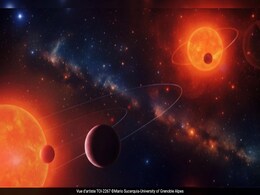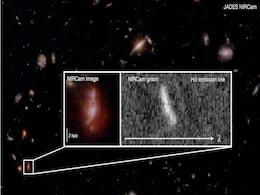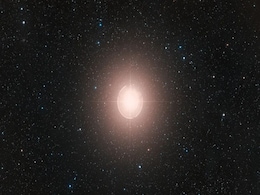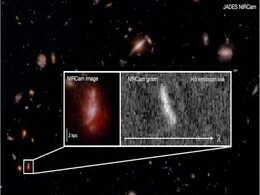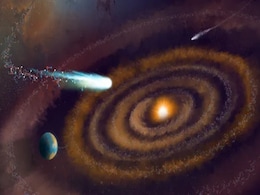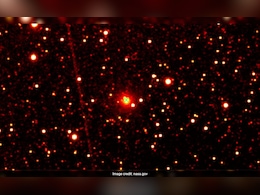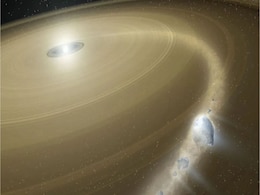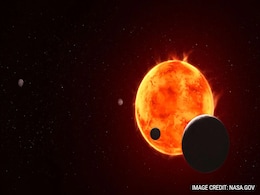Star System
- All
- News
- Videos
- Web Stories
-

NASA's Astronomers Reveal Red Giant Stars May Destroy Their Own Planets
- Monday November 10, 2025
- Science | Edited by Astitva Raj
This extreme expansion poses a serious threat to nearby planets. For example, when the Sun becomes a red giant in about 5 billion years, it will likely swallow Mercury and Venus.
-
 www.ndtv.com
www.ndtv.com
-

Astronomers Spot Signs of Baby Planets in a Star’s Mysterious Disk
- Friday November 7, 2025
- Written by Gadgets 360 Staff
Astronomers using Keck Observatory have imaged the dusty disk around HD 34282, a young star about 400 light-years away, revealing bright clumps and a 40 AU gap—clear signs of planet formation. The system provides a rare glimpse into early planetary birth, helping refine models of how gas and dust evolve into new worlds.
-
 www.gadgets360.com
www.gadgets360.com
-

Mystery Deepens as Interstellar Comet 3I/ATLAS Brightens Unexpectedly Near the Sun
- Thursday November 6, 2025
- Written by Gadgets 360 Staff
Interstellar comet 3I/ATLAS defied expectations during its 2025 solar flyby, brightening far faster than predicted. Observatories worldwide recorded a blue coma rich in exotic gases, suggesting unique chemistry from another star system. Scientists are investigating whether its unusual composition or speed caused the outburst, marking a new interste...
-
 www.gadgets360.com
www.gadgets360.com
-

Interstellar Visitor 3I/ATLAS Brightens Faster Than Expected, Surprising Scientists
- Tuesday November 4, 2025
- Written by Gadgets 360 Staff
The interstellar comet 3I/ATLAS has brightened far faster than expected during its solar approach, surprising researchers. Scientists say the unusual surge may point to rare chemical traits from another star system. Further observations in 2025 may reveal why this cosmic visitor behaves differently from typical comets in our solar neighbourhood.
-
 www.gadgets360.com
www.gadgets360.com
-

Astronomers Stunned By Three Earth-Sized Planets In Distant Unique Planetary System
- Wednesday October 29, 2025
- Science | Edited by Srishti Singh Sisodia
The study revealed that TOI-2267 has two closely bound stars orbiting each other, and the third planet transits the companion star.
-
 www.ndtv.com
www.ndtv.com
-

James Webb Telescope Finds Early Universe Galaxies Were More Chaotic Than We Thought
- Thursday October 23, 2025
- Written by Gadgets 360 Staff
The James Webb Space Telescope has revealed that galaxies in the early universe were far more chaotic and unstable than once believed. A new study shows that gas turbulence and intense star formation disrupted young galaxies, reshaping scientists’ understanding of how galaxies evolved into the structured systems seen today.
-
 www.gadgets360.com
www.gadgets360.com
-

NASA Telescopes Capture First-Ever Companion Star Orbiting Massive Red Supergiant Betelgeuse
- Sunday October 26, 2025
- Written by Gadgets 360 Staff
Astronomers have detected a small companion star orbiting the red supergiant Betelgeuse using Hubble and Chandra observations. Dubbed “Betelbuddy,” the discovery reveals an extreme binary system that challenges existing models of stellar evolution and may offer clues to Betelgeuse’s future.
-
 www.gadgets360.com
www.gadgets360.com
-

James Webb Telescope Uncovers the Turbulent Birth of the First Galaxies
- Saturday October 25, 2025
- Written by Gadgets 360 Staff
Using JWST data, astronomers analyzed more than 250 galaxies from the universe’s first 1.5 billion years and found most were chaotic, with gas swirling in all directions. Only a few showed early signs of ordered rotation. The findings reveal how intense star formation and gravitational turbulence gave way to stability, transforming the early univ...
-
 www.gadgets360.com
www.gadgets360.com
-

Astronomers Detect Heavy Water in Planet-Forming Disk Around Young Star
- Monday October 20, 2025
- Written by Gadgets 360 Staff
Scientists have detected heavy water in the planet-forming disk around young star V883 Orionis, confirming the water existed long before the star formed. The discovery, made using ALMA, shows that water’s origins trace back to ancient interstellar clouds, linking molecular gas, comets, and planetary systems across billions of years.
-
 www.gadgets360.com
www.gadgets360.com
-

Trump's Dream, China's Reality: Beijing Develops Planet-Wide Defence System
- Tuesday October 14, 2025
- World News | Edited by Sanstuti Nath
China has reportedly developed a first-of-its-kind missile defence system with a worldwide reach.
-
 www.ndtv.com
www.ndtv.com
-

Legally Veer Is Streaming Now: Know Where to Watch the Critically Acclaimed Courtroom Drama
- Sunday October 12, 2025
- Written by Gadgets 360 Staff
Get ready for "Legally Veer," the explosive new legal drama streaming on Lionsgate Play. Follow the journey of Veer as they navigate power, passion, and the pursuit of justice, challenging the system and proving their worth in a world of legal giants.
-
 www.gadgets360.com
www.gadgets360.com
-

5 Hotels With The Best Architecture And Design, According To The Michelin Guide
- Tuesday October 7, 2025
- Travel | Written by Toshita Sahni, Edited by Shubham Bhatnagar
Michelin Key 2025: These five hotels transcend the notion of "pretty buildings" by embedding narrative, climate awareness, local identity and spatial drama into each stay.
-
 www.ndtv.com/travel
www.ndtv.com/travel
-

Interstellar Comet Swinging Past Mars As A Fleet Of Spacecraft Looks On
- Thursday October 2, 2025
- Science | Associated Press
A comet from another star system will swing by Mars on Friday as a fleet of spacecraft trains its sights on the interstellar visitor.
-
 www.ndtv.com
www.ndtv.com
-

Hubble Spots White Dwarf Devouring Icy Pluto-Like Planet 260 Light-Years Away
- Wednesday September 24, 2025
- Written by Gadgets 360 Staff
Using Hubble’s ultraviolet spectrograph, scientists detected carbon, nitrogen, sulphur, and abundant oxygen falling onto a white dwarf 260 light-years away, evidence of an icy planetesimal being torn apart. The find shows volatile worlds can persist into a star’s final stages, offering a preview of the Sun’s distant fate.
-
 www.gadgets360.com
www.gadgets360.com
-

Not Like Venus Or Mars, Distant Exoplanet May Have Atmosphere Like Earth's
- Friday September 19, 2025
- World News | Edited by NDTV News Desk
A distant exoplanet might have an atmosphere similar to Earth's, early observations from the James Webb Space Telescope (JWST) suggest. It is part of a group of planets orbiting a star called TRAPPIST-1, about 40 light-years away from Earth.
-
 www.ndtv.com
www.ndtv.com
-

NASA's Astronomers Reveal Red Giant Stars May Destroy Their Own Planets
- Monday November 10, 2025
- Science | Edited by Astitva Raj
This extreme expansion poses a serious threat to nearby planets. For example, when the Sun becomes a red giant in about 5 billion years, it will likely swallow Mercury and Venus.
-
 www.ndtv.com
www.ndtv.com
-

Astronomers Spot Signs of Baby Planets in a Star’s Mysterious Disk
- Friday November 7, 2025
- Written by Gadgets 360 Staff
Astronomers using Keck Observatory have imaged the dusty disk around HD 34282, a young star about 400 light-years away, revealing bright clumps and a 40 AU gap—clear signs of planet formation. The system provides a rare glimpse into early planetary birth, helping refine models of how gas and dust evolve into new worlds.
-
 www.gadgets360.com
www.gadgets360.com
-

Mystery Deepens as Interstellar Comet 3I/ATLAS Brightens Unexpectedly Near the Sun
- Thursday November 6, 2025
- Written by Gadgets 360 Staff
Interstellar comet 3I/ATLAS defied expectations during its 2025 solar flyby, brightening far faster than predicted. Observatories worldwide recorded a blue coma rich in exotic gases, suggesting unique chemistry from another star system. Scientists are investigating whether its unusual composition or speed caused the outburst, marking a new interste...
-
 www.gadgets360.com
www.gadgets360.com
-

Interstellar Visitor 3I/ATLAS Brightens Faster Than Expected, Surprising Scientists
- Tuesday November 4, 2025
- Written by Gadgets 360 Staff
The interstellar comet 3I/ATLAS has brightened far faster than expected during its solar approach, surprising researchers. Scientists say the unusual surge may point to rare chemical traits from another star system. Further observations in 2025 may reveal why this cosmic visitor behaves differently from typical comets in our solar neighbourhood.
-
 www.gadgets360.com
www.gadgets360.com
-

Astronomers Stunned By Three Earth-Sized Planets In Distant Unique Planetary System
- Wednesday October 29, 2025
- Science | Edited by Srishti Singh Sisodia
The study revealed that TOI-2267 has two closely bound stars orbiting each other, and the third planet transits the companion star.
-
 www.ndtv.com
www.ndtv.com
-

James Webb Telescope Finds Early Universe Galaxies Were More Chaotic Than We Thought
- Thursday October 23, 2025
- Written by Gadgets 360 Staff
The James Webb Space Telescope has revealed that galaxies in the early universe were far more chaotic and unstable than once believed. A new study shows that gas turbulence and intense star formation disrupted young galaxies, reshaping scientists’ understanding of how galaxies evolved into the structured systems seen today.
-
 www.gadgets360.com
www.gadgets360.com
-

NASA Telescopes Capture First-Ever Companion Star Orbiting Massive Red Supergiant Betelgeuse
- Sunday October 26, 2025
- Written by Gadgets 360 Staff
Astronomers have detected a small companion star orbiting the red supergiant Betelgeuse using Hubble and Chandra observations. Dubbed “Betelbuddy,” the discovery reveals an extreme binary system that challenges existing models of stellar evolution and may offer clues to Betelgeuse’s future.
-
 www.gadgets360.com
www.gadgets360.com
-

James Webb Telescope Uncovers the Turbulent Birth of the First Galaxies
- Saturday October 25, 2025
- Written by Gadgets 360 Staff
Using JWST data, astronomers analyzed more than 250 galaxies from the universe’s first 1.5 billion years and found most were chaotic, with gas swirling in all directions. Only a few showed early signs of ordered rotation. The findings reveal how intense star formation and gravitational turbulence gave way to stability, transforming the early univ...
-
 www.gadgets360.com
www.gadgets360.com
-

Astronomers Detect Heavy Water in Planet-Forming Disk Around Young Star
- Monday October 20, 2025
- Written by Gadgets 360 Staff
Scientists have detected heavy water in the planet-forming disk around young star V883 Orionis, confirming the water existed long before the star formed. The discovery, made using ALMA, shows that water’s origins trace back to ancient interstellar clouds, linking molecular gas, comets, and planetary systems across billions of years.
-
 www.gadgets360.com
www.gadgets360.com
-

Trump's Dream, China's Reality: Beijing Develops Planet-Wide Defence System
- Tuesday October 14, 2025
- World News | Edited by Sanstuti Nath
China has reportedly developed a first-of-its-kind missile defence system with a worldwide reach.
-
 www.ndtv.com
www.ndtv.com
-

Legally Veer Is Streaming Now: Know Where to Watch the Critically Acclaimed Courtroom Drama
- Sunday October 12, 2025
- Written by Gadgets 360 Staff
Get ready for "Legally Veer," the explosive new legal drama streaming on Lionsgate Play. Follow the journey of Veer as they navigate power, passion, and the pursuit of justice, challenging the system and proving their worth in a world of legal giants.
-
 www.gadgets360.com
www.gadgets360.com
-

5 Hotels With The Best Architecture And Design, According To The Michelin Guide
- Tuesday October 7, 2025
- Travel | Written by Toshita Sahni, Edited by Shubham Bhatnagar
Michelin Key 2025: These five hotels transcend the notion of "pretty buildings" by embedding narrative, climate awareness, local identity and spatial drama into each stay.
-
 www.ndtv.com/travel
www.ndtv.com/travel
-

Interstellar Comet Swinging Past Mars As A Fleet Of Spacecraft Looks On
- Thursday October 2, 2025
- Science | Associated Press
A comet from another star system will swing by Mars on Friday as a fleet of spacecraft trains its sights on the interstellar visitor.
-
 www.ndtv.com
www.ndtv.com
-

Hubble Spots White Dwarf Devouring Icy Pluto-Like Planet 260 Light-Years Away
- Wednesday September 24, 2025
- Written by Gadgets 360 Staff
Using Hubble’s ultraviolet spectrograph, scientists detected carbon, nitrogen, sulphur, and abundant oxygen falling onto a white dwarf 260 light-years away, evidence of an icy planetesimal being torn apart. The find shows volatile worlds can persist into a star’s final stages, offering a preview of the Sun’s distant fate.
-
 www.gadgets360.com
www.gadgets360.com
-

Not Like Venus Or Mars, Distant Exoplanet May Have Atmosphere Like Earth's
- Friday September 19, 2025
- World News | Edited by NDTV News Desk
A distant exoplanet might have an atmosphere similar to Earth's, early observations from the James Webb Space Telescope (JWST) suggest. It is part of a group of planets orbiting a star called TRAPPIST-1, about 40 light-years away from Earth.
-
 www.ndtv.com
www.ndtv.com





